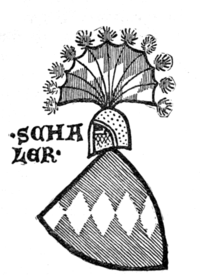taken from seals, and it is quite possible that the actual fans upon the seal helmets had some device painted upon them which it was impossible by reason of the size to represent upon the seal. As has been already stated, the great seal of Richard I. does show a lion painted on the fan.
There are many examples of the heraldic development of these fans,—for their use obtained even in this country long after the real heraldic crest had an assured footing—and a typical example occurs in Fig. 613, but probably the best-known instance, one which has been often illustrated, is that from the effigy of Sir Geoffrey de Luttrell (c. 1340), which shows a fan of this character upon which the entire Luttrell arms are depicted.
A much later instance in this country will be found in the seal (dated 1539) of the City of London, which shows upon the helmet one of these fan-shaped ornaments, charged with the cross of the City arms (Fig. 614).
The arms of the City of London are recorded in the College of Arms (Vincent) without a crest (and by the way without supporters) and this seal affords a curious but a very striking and authentic instance of the extreme accuracy of the records of the College of Arms. There being no crest for the City of London at the time of the preparation of this seal, recourse was had to the ancient practice of depicting the whole or a part (in this case a part) of the device of the shield upon a fan surmounting the helmet. In course of time this fan, in the case of London, as in so many other cases, has through ignorance been


